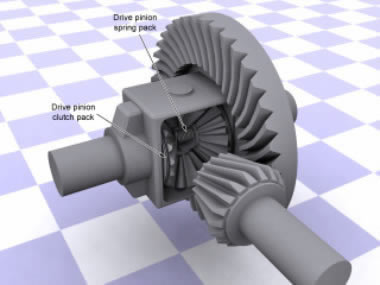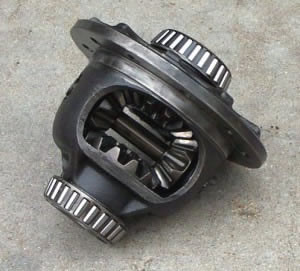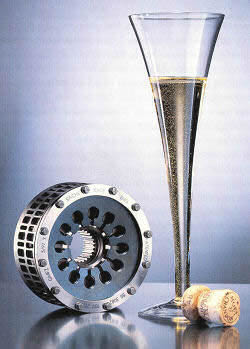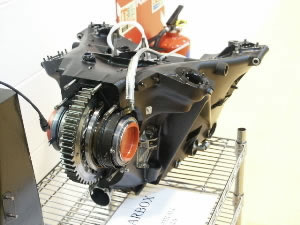Differential
On the one end of the gearbox lives the engine with clutch, and on other end differential - an essential part of the drive train where drivability is concerned. As it travels around a corner, the car will map out a curved path the width of the car itself.
The inside arc of the path will be of tighter radius than the outside one, and so the wheel on the outside will have to travel further and so rotate at a different (higher) speed to the wheel on the inside. If the two wheels were directly connected, the loaded wheel (on the outer, longer arc) would force the inner wheel to rotate at the same speed, and the tire would spin and scrub along the ground. To solve this, in sport cars and F1, the 'limited-slip differential' is used, compared to open differentials used in most family cars.
 |
http://www.carbibles.com/Internals of an Limited slip differential in sport cars |
 |
Internals of an Limited slip differential in sport cars
|
 |
Open slip differential in road car
|
 |
http://www.carbibles.com/Open slip differential in road car |
The open differential theoretically delivers equal torque to both drive wheels at all times, whereas a limited slip device uses friction to change the torque relationship between the driven wheels.
This allows the sport car wheels to roll at separate speeds to each other when the car is entering the corner, then as the driver comes back on the power, the differential will slowly lock up to avoid the inside, unloaded wheel spinning. Of course, like most things on a Formula One car, this is all electronically controlled, and can be programmed into the car - in fact, until it was banned, there was a button on the steering wheel which drivers could press to manually lock or release the diff as they pleased, enabling them to get better traction out of the corners.
Electro-hydraulic devices are used in F1 to constantly change the torque acting on both of the drive wheels at different stages in a corner. This torque relationship can be varied to 'steer' the car through corners, or prevent the inside rear wheel from spinning under harsh acceleration out of a bend. The FIA allows the use of these devices provided that their Characteristics are fixed once the car is out on the track.
A Moog electrohydraulyc valve (from RaceCar-Engineering, Charles Armstrong Wilson, 2008) will constantly adjust the friction between the two shafts around the track to maximize the performance of the car dependent on what characteristics have been entered into the on-board computer.

The Moog valve opens and closes depending on what the software is telling it to do, but the valve must work to the same set of conditions that are pre-programmed whilst the car is in the pits. This means that the driver cannot actually alter the characteristics of the differential due to a change in tracks conditions for instance, which was allowed in the days of the many driver aids around 1993.
A Moog valve is based on technology developed during World War Two due the need to convert an analog electrical signal into a proportional hydraulic oil pressure differential which in turn drives a spool valve. this valve controls the flow, pressure and flow velocity of hydraulic actuator or cylinder. Moog valves are popular in Formula 1 because they control equipment with precision and with very high response and therefore facilitate the operation of all servo-hydraulic control systems currently used.

The wineglas and champagne bottle cork provide a remarkable
prospective for this ZF Sachs Formula 1 clutch. Though tiny,
only 111 mm in diameter, it can transmit more than 900 horse power.







